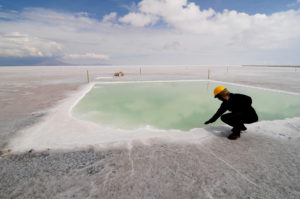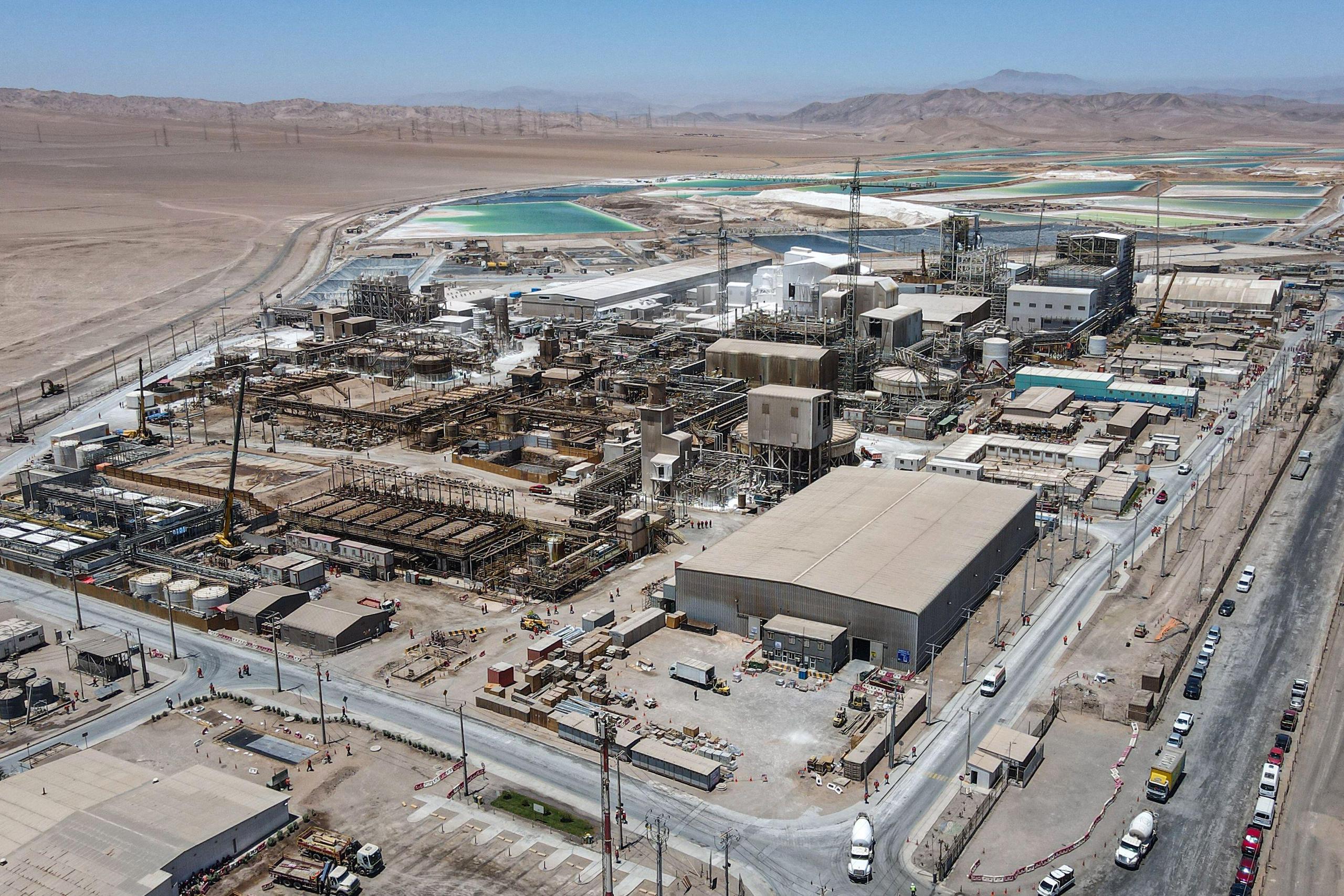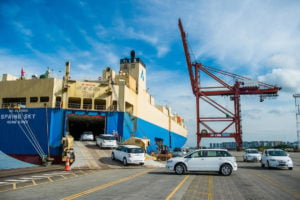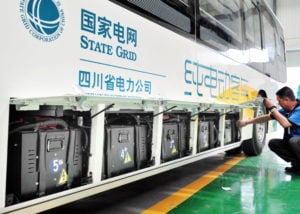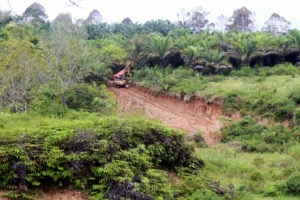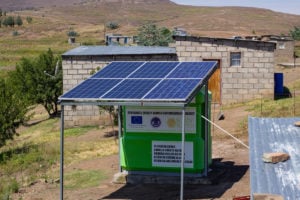Lithium is an essential ingredient in batteries for electric vehicles (EVs), and the global energy transition has seen prices of lithium compounds rocket. In January 2021, a tonne of battery-grade lithium carbonate cost 40,000–60,000 yuan (US$5,600–8,400). By the end of 2022, it was ten times that, at over 500,000 yuan a tonne.
The potential profits triggered a lithium mining rush, with the city of Yichun in Jiangxi province providing a typical example. Plans for Yichun to become the “lithium capital of Asia” had first been proposed in 2008, and the city was desperate to seize the opportunity brought by the sky high prices. But unregulated mining and processing of the metal caused pollution scares and environmental damage.
In February this year, the central government dispatched a cross-departmental team to Yichun to investigate and rectify these issues, with uncontrolled lithium mining and processing halted. Two months later, the Ministry of Natural Resources approved two lithium mining projects, one in Sichuan and one in Qinghai.
So the government is both cracking down on unregulated lithium production and allowing regulated production to expand. This indicates China’s lithium sector is to expand and improve.
Helped by its position as by far the biggest producer of EV batteries, China has also become the world’s biggest supplier of lithium compounds. But the country currently has inadequate domestic supply of upstream raw materials of lithium, including ores and brines, and so still relies on imports. To sustain lithium supply, the steady extraction, processing and trading of lithium resources are critical to China.
The increasingly competitive environment and geopolitical headwinds are posing new challenges for Chinese lithium companies. As the EU and US have legislated to bolster self-sufficiency and competitiveness in their supply chains for critical materials, the international market has been wary of Chinese investment. The challenge makes it important for Chinese companies to be aware of the environmental, resource and social impacts of lithium production and the green and low-carbon supply chain, to ensure advantage and build up trust.
‘White gold’
The low-carbon transition requires a range of rare metals and earths, often referred to as “transition metals” or “critical minerals”. Deposits are unevenly distributed and supplies insecure, making them of strategic value and a focus of international competition.
Lithium is a white metal traditionally used in ceramics and glassmaking. More recently, it has found a role in the manufacturing of EV batteries, consumer electronics and energy-storage systems. In EV batteries, lithium is used to produce key parts including electrodes and electrolyte. And with no economically viable alternative in sight, the rapid expansion of the EV industry has pushed output and demand for lithium to new heights, fulfilling its nickname “white gold”.
In 2021, global lithium production passed the 100,000-tonne mark for the first time, with 74% of that going into batteries. According to a 2022 forecast from the International Energy Agency, demand will keep rising so that by 2040 it is 40 times higher than in 2020 – faster growth than the other critical minerals.
China, the world’s biggest importer and refiner of lithium, has become a hub for the global lithium supply, supporting and driving the world’s clean energy transition. It relies on imports for about 65% of its supply, and after processing, most lithium is sold to battery manufacturers. China itself requires a secure and stable source: its EV battery makers account for half of the global market and require increasing quantities of lithium.
China has designated lithium a strategic mineral and plans to expand production in Qinghai, Tibet, Sichuan and Jiangxi. To ensure supplies, many Chinese firms have looked overseas, investing in lithium mines in Africa or brines in South America.
But resource and environmental concerns are on the rise.
Impact of lithium mining
Lithium is either mined from ore deposits or extracted from brines. Ore deposits are concentrated in Brazil and Australia, while brines are mostly located in the “lithium triangle” of Bolivia, Chile and Argentina.
Lithium mining from ores is the more mature and widespread technology. Ores are taken from mines, washed and refined, and ultimately processed into lithium carbonate or lithium hydroxide for use in batteries. In China, lithium ores are found mainly in Sichuan and Jiangxi. In Yichun, Jiangxi, the rocketing price of lithium in the past two years led to a rush of disorderly mining and trading of the metal. Dozens of local ceramics firms switched their production lines to bake lithium mica.
According to one mining sector due diligence expert: “Unregulated lithium extraction is crude and low-tech, with no attention paid to pollution. It is extremely easy for pollution problems to result.”
In November 2022, excessive levels of thallium were found in a local river in Yichun. This heavy metal, often found with other metal ores, is toxic and a focus of China’s efforts to control heavy metal pollution. The local government traced the thallium pollution to a local lead recycler and confirmed that there was also a link with local lithium carbonate producers. According to media reports, in April and May of last year the provincial environmental authorities investigated seven Yichun lithium firms, finding handling of thallium-containing waste to be inadequate and the destination of the waste unclear.
There are earlier examples of environmental issues arising from lithium mining. Ten years ago, there was a serious pollution incident originating at a lithium mine in Sichuan. In 2016 and 2017, a number of Yichun mines were found to be causing air pollution and ecological damage.
Waste-handling, recycling and reuse are also challenges. Industry insiders estimate that if Yichun hits its 2025 production target of lithium carbonate that will produce tens of millions of tonnes of waste annually – far more than can be handled locally.
Constraints in lithium extraction from brines
The other method of lithium mining – extraction from brines – can use up huge quantities of water and electricity.
Brines tend to form in high-altitude arid and semi-arid regions, where the environment is already vulnerable. According to a 2016 study, the bulk of China’s lithium reserves (86.8% of lithium brine and 60.6% of lithium ore) are found on the ecologically vulnerable Qinghai–Tibetan Plateau. The conditions there are harsh and infrastructure underdeveloped, making extraction harder.
In brines with a higher lithium content, it is common practice to extract the metal by evaporation. But the drying and precipitation requires large expanses of salt pans, and every tonne of lithium carbonate collected produces about 115 tonnes of waste. In brines with lower levels of lithium, adsorption and membrane filtration are currently used. These techniques require a lot of electricity and freshwater, which are scarce in high-altitude arid regions. Publicly available data puts the amount of water needed to produce a tonne of lithium carbonate this way at between 350 and 470 tonnes – almost ten times as much as the evaporation method.
Extraction of lithium from brines can have cumulative impacts on local water resources and ecosystems. Brine is pumped from the centre of the aquifer, causing surrounding underground freshwater to flow inwards as the aquifer recharges. In the long term, this may cause water shortages for those living nearby.
Early last year, a planned BYD lithium project in Chile was suspended partly due to opposition from local Indigenous people and communities concerned about pollution. In the Argentine province of Jujuy, there was controversy over a brine project invested in by Chinese firm Ganfeng Lithium, with concerns focused on the impact the associated water use would have on the ecology and local livelihoods.
Cleaner and more efficient tech
In April this year, researchers writing in Nature magazine opined: “If nothing changes, simply ramping up lithium production at existing sites could negate the benefits of the clean technologies they power.” Lessons from Yichun and overseas sites show that the impact of lithium mining on the environment, ecology, resources, energy and communities needs to be handled properly for lithium to become a “green metal”. This will need changes in technology, policy and supply chains.
Many firms have reduced their ecological and environmental footprints by changing how they extract lithium. For example, Livent, a US-headquartered company which makes battery materials, says it has reduced the amount of freshwater needed to produce a tonne of lithium carbonate to about 72 tonnes after implementing a sustainable water programme. It aims to be able to expand production without using additional freshwater.
When it comes to electricity, the industry is upbeat about using local sunlight at high-altitude brine sites by deploying solar PV and solar thermal, combined with energy storage. For example, Ganfeng Lithium’s Mariana brine project in Argentina includes a PV power plant, and the intention is to power the entire project with renewable energy. A major mining firm, Zijin Mining, is also planning to instal solar panels over its waste storage sites to provide clean power.
The trend in lithium extraction is to make better use of resources and reduce negative environmental impacts. This can include shortening the extraction process, reusing waste from the battery-production process, recycling, and reusing batteries, and fostering unconventional approaches such as extracting lithium from oil beds, a by-product of oil drilling.
These innovations will need policy guidance and cooperation across the supply chain if they are to add more value.
Most cutting-edge lithium extraction tech is still in the experimental stage and not ready to be rolled out at scale. Governments, research bodies and businesses will need to bolster coordination. For example, government and private venture capital funds could incubate low-carbon and clean lithium technology. And to prevent bad money driving out the good, more needs to be done to tackle rule-breaking in lithium extraction and processing, with environmental risks eliminated.
Supply chain cooperation
Lithium extraction and processing firms are at the upstream of the supply chain. Their performance on environmental and carbon issues flows all the way downstream to the final branded products. Cooperation along the supply chain is particularly important during these difficult geopolitical times. Major importers such as the US and EU have put legislation in place for procurement of certain minerals, requiring downstream buyers to bolster disclosure and due diligence to eliminate environmental and human rights risks in their supply chains.
“Currently, in the strong buyer’s market, the downstream players are putting pressure on upstream suppliers by due diligence practice. But the ultimate goal is for supply chain management – not merely for passing the audit. That’s getting things back to front,” said Sun Lihui, director of the development department at the China Chamber of Commerce of Metals, Minerals and Chemicals (CCCMC). “A more positive approach would be to build partnerships between upstream and downstream players, helping miners to improve performance while sharing costs and establishing a fair dialogue.”
Marina Yue Zhang, an associate professor at the Australia-China Relations Institute, University of Technology Sydney, wrote recently that: “China has invested heavily in transitioning to clean energy, including developing technologies and production know-how covering the entire lithium supply chain. It has paid substantial environmental costs through trial-and-error innovation and has now developed dominant advantages in… green technologies used in lithium processing.” She calls for better international cooperation in lithium supply chains so other countries do not have to incur similar costs, saying such cooperation is essential for tackling climate change.
Currently, China has no compulsory environmental or social due diligence requirements for the lithium supply chain, but CCCMC has taken a positive first step. In May 2022, it issued a second edition of its due diligence guidance for minerals supply chains. That document suggests upstream suppliers and downstream buyers set up due diligence systems designed to prevent risks and strengthen management of environmental, ecological, climate and social risks.
“Over the last two years, we’ve seen more attention being paid to due diligence in the lithium supply chain, with some firms already taking action,” said Sun. “And mining firms don’t set up due diligence systems just to deal with audits from downstream buyers, but to improve their ability to manage the supply chain. The key is the recognition from company executives, cross-departmental cooperation, support from companies across the supply chain, and participation from all stakeholders.”
